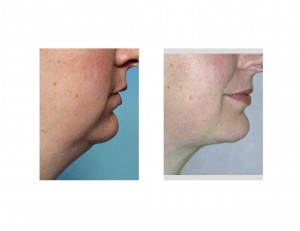Unhappiness with the shape of one’s neck is a common cosmetic concern. It is important to differentiate between a full neck, which is a fat problem, from that of a neck wattle which is more of a skin issue than that of fat. Usually a neck shape that is due primarily to fat is associated with thicker, more elastic skin and the patient is often younger. (under age 50)
The use of liposuction to shape up a fuller neck is a very simple and effective procedure. A surprising amount of fat can be suctioned from some necks. Liposuction in this lower facial area can be divided into submental or neck liposuction. This distinction reflects the amount of area that can be suctioned. Submental refers to the area just under the chin. Neck liposuction covers a broader area which includes the submental and out into the sides of the neck. Neck liposuction is done between the jugular veins and the anterior border of the sternocleidomastoid muscles. Crossing these boundaries could result in laceration or rupture of a jugular vein, an event to be avoided. For this reason, patients should not expect as much improvement in the side of the neck as occurs under the chin.

One expected outcome that patients do not consider when undergoing neck liposuction is how the area will temporarily feel and look after surgery. While an immediate and sometimes dramatic result can be seen immediately on the operating table, swelling and bruising will occur later. While the use of neck straps and dressings is helpful to reduce this inevitable reaction, there is no way to get good sustained compression without pressing on your airway. In addition, patients do not like to wear neck straps very long as they are socially restrictive.

While this process occurs in all forms of liposuction, I have found in my Indianapolis plastic surgery practice that laser liposuction seems to have less of this reaction. It may be that the heat generated in performing it causes less inflammation and lymphatic leak. When neck liposuction is being performed as a stand alone procedure, it can be very comfortably done under local anesthesia using the laser probe and small suction cannulae.
Barry L. Eppley, M.D., D.M.D.
Indianapolis, Indiana


